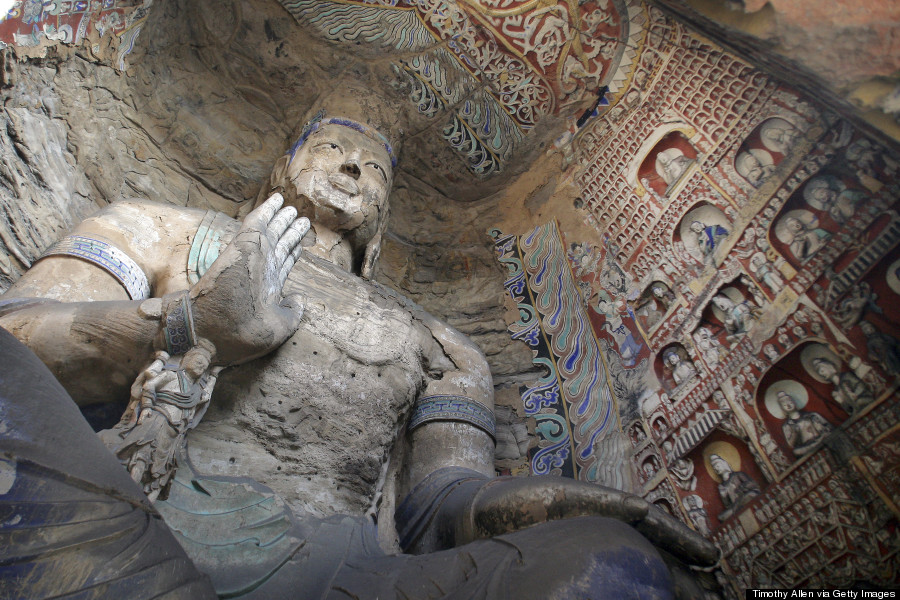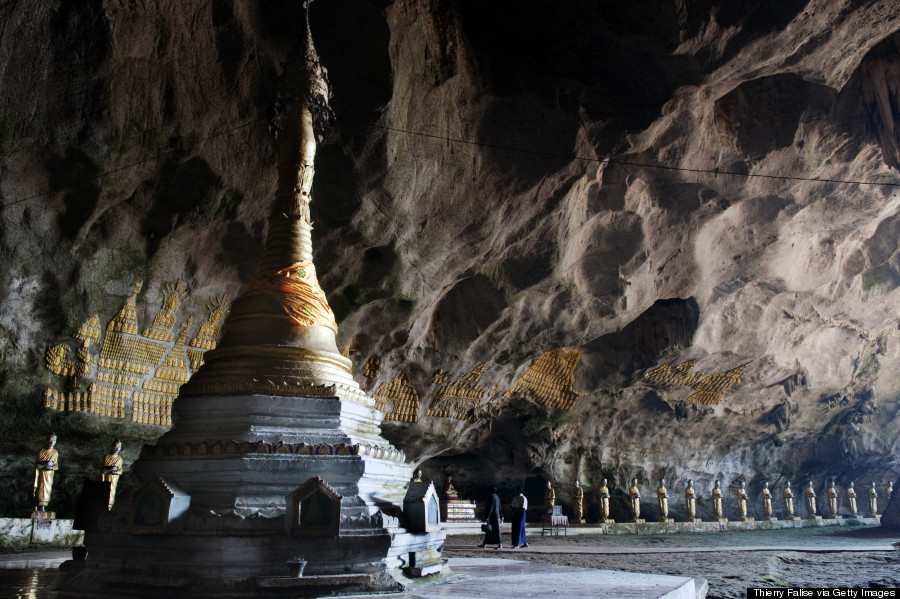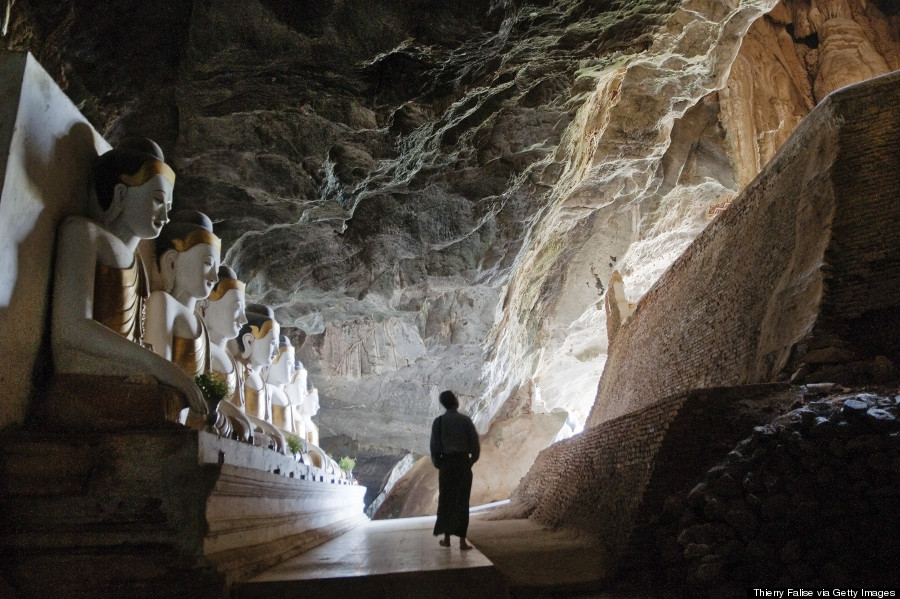Our Appreciation Towards Kim
Help support her dream in bringing a wild unknown to all of our lives by visiting her website and checking out all that she has created! Shop here to support>>
Help support her dream in bringing a wild unknown to all of our lives by visiting her website and checking out all that she has created! Shop here to support>>
The isolation of these sites serves to intensify the spiritual connection experienced by visitors. While some places of worship use architectural height to draw attention up to the heavens, these cave temples highlight the value of spiritual treasures that lie within.
Datdawtaung Cave
Mandalay region, Myanmar
Khao Luang Cave Temple
Phetburi, Thailand
Pindaya Caves
Pindaya, Myanmar
Phraya Nakhon Cave
Khao Sam Roi Yot National Park, Thailand
Yungang Grottoes
Shanxi, China
Wat Tham Erawan
Nong Bua Lamphu province, Thailand
Sadan Cave
Kayin State, Myanmar
Ellora Caves
Maharashtra, India
Yathae Pyan Cave
Kayin state, Myanmar
The post (PHOTOS) 9 Jaw-Droppingly Gorgeous Buddhist Temples that Will Blow Your Mind appeared first on YOGANONYMOUS.
This is a result of home products made with toxic chemicals, such as vinyl flooring and air fresheners. If you don’t want to stop using these products and leaving the windows open all the time isn’t an option, there are house plants that can help detoxify your indoor air. Here are some of the more effective.
 Aloe Vera
Aloe Vera Purple Waffle Plant
Purple Waffle Plant
Researchers at the University of Georgia tested 28 common indoor decorative plants for their ability to remove the top five indoor pollutants. And the purple waffle plant was rated one of the best detoxifiers. This showy, low-maintenance spreading plant is an excellent choice as ground cover in a terrarium or to drape over a cupboard.
 Areca Palm
Areca Palm
This beautiful palm tree pumps out loads of oxygen during the day and was rated by NASA as having the eighth highest removal rate for formaldehyde – a chemical often found in carpeting. Additionally, the Areca palm helps restore moisture to dry winter air at levels comparable to an electric humidifier.
 Peace Lily
Peace Lily
This lily absorbs pollutants such as formaldehyde (found in carpeting) trichloroethylene (found in plastics), benzene (found in paints),and xylene (found in adhesives). The peace lily requires watering once a week and your choice of a bright or shaded home. Even though this is a “peace” lily, which is less toxic than true lilies, it still can pack a toxic punch if consumed by pets.
 Rubber Plant
Rubber Plant
The thick, deep green leaves of rubber plants help filter formaldehyde, benzene and ammonia from the air – all while improving the aesthetic of your living space. This somewhat demanding plant requires high light and frequent deep watering, and should also be kept far away from animals or children, as it is poisonous when consumed.
 Mother-In-Law’s Tongue
Mother-In-Law’s Tongue Golden Pothos
Golden Pothos
This fast-growing vine absorbs formaldehyde, benzene and xylene. Placing this plant in or near the garage is good choice since engine exhaust is a primary source of formaldehyde.
 English Ivy
English Ivy
This glossy climbing plant comes in a variety of shades and is typically grown as a hanging plant that will also climb up walls or beams. Relatively easy to grow, English ivy is excellent at removing benzene from the air and also reduces airborne particles of fecal matter.
 Money Plant
Money Plant
This superhero plant is an all-around air purifier that can remove formaldehyde and many other pollutants. It is also believed to bring the owner good luck, good fortune and good health in Chinese culture, where Money plants are often given as gifts on the Chinese New Year. Unfortunately, this type of bonsai tree is toxic to cats and dogs when ingested, and should also be kept out of reach of children.
 Red-edged dracaena
Red-edged dracaena
Consider this plant if you’d like to add a pop of color to a room. The red-edged leaves are very attractive, and this plant can grow up to 15 feet tall–all while removing airborne chemicals from lacquers, varnishes and gasoline.

Spider Plant
This “spider” is tough to kill – but that’s a good thing because unlike its creepy-crawly namesake, you’ll really want this plant to thrive in your home. It has long wispy leaves and tiny white flowers. The spider plant destroys benzene, formaldehyde, carbon monoxide and xylene – a solvent found in leather and rubber.
The post 10 House Plants that will Detox Your Home appeared first on YOGANONYMOUS.
Lljones00Wonderful information <3

I’ve spent the last two days trying to write a concise, easy guide to essential oils and their safety, and it ended up being just an enormous dump of information that no would want to ingest in a single blog post.
Therefore, you’re getting the quickest, easiest 21 facts you need to keep in mind. These things include safety measures, essential oil facts, therapeutic uses, and more. You’ll like this better. I promise.
However, at the end of this post, I am going to give extensive references to those of you who would like to learn more about the fascinating world of essential oils, as well as a list of my top 7 recommended essential oils for any household to have.
Essential oils are not really oils. They do not contain the fatty acids that constitute what we would consider an actual oil. Valerie Gennari Cooksley, author of Aromatherapy: Soothing Remedies to Restore, Rejuvenate and Heal defines essential oils as “highly concentrated plant constituents possessing potent medicinal and cosmetic qualities.” However, I think Stephanie Tourles nailed it in Organic Body Care recipes when she said, “I consider essential oils the life force or the soul of the plant.”
Most essential oils are high in antibacterial, antifungal, and antiviral properties: This makes them an excellent addition to your homemade cleaning preparations. Oils that are best for cleaning are: Lemon, grapefruit, eucalyptus, peppermint, tea tree, lavender, and rosemary.
Essential oils are miniscule in molecular size, which means they are absorbed well by the skin – making them perfect ingredients in personal care items intended to heal, soften, and nourish. However, they do not accumulate in the body over time – they simply offer up their healing properties and then pass on through.
Scientific studies have shown that rosemary essential oil helps your brain perform. Specifically, smelling rosemary essential oil helps memory recall and performance on tests. Interestingly, this study also showed that groups that inhaled either rosemary or lavender essential oil felt much more relaxed than those who inhaled no odor at all.
Fragrance oils and essential oils are NOT the same thing. As a rule of thumb, if you see the word “fragrance” or “fragrance oil” or even “perfume” on anything, you can assume this is synthetic and NOT natural. (Even if it says natural fragrance.)
Essential oils are wholly natural and cannot be patented; which means that you’ll never see an essential oil in a pharmaceutical drug. As such, you can expect that the vast majority of mainstream healthcare practitioners will never recommend essential oils as therapeutic alternatives to drugs. More importantly, because essential oils cannot be patented, drug companies will not waste money studying them. This limits our scientific knowledge of essential oils greatly, and the majority of what we know about them are things that have been passed down through thousands of years of personal use and experimentation.
Enormous amounts of plants are needed to produce essential oil. In fact, on the extreme end, it takes 4000 pounds of Bulgarian roses to produce 1 pound of essential oil. Other plants like lavender only take 100 pounds of plant material to produce a pound of essential oil. Still, can you imagine how concentrated essential oils must be, in light of how many plants are used to produce them?
Most essential oils should never be used undiluted on the skin. Instead, they should be combined with “real” oils (called carrier oils), waxes, butters, alcohols, or other diluting measures. Because they’re so concentrated, if you don’t dilute, you may end up with an unfortunate reaction (and unhappy skin).
There are a few essential oils that are generally recognized as safe to use undiluted. Of course, there has to be a few exceptions to the rule. Again, in Organic Body Care Recipes, the author points out that the only essential oils that are widely acknowledged as safe to use undiluted (sparingly) are: lavender, German chamomile, tea tree, sandalwood, and rose geranium.
Never use an undiluted essential oil on a baby or child. Children have much thinner, more delicate skin than adults have, and tend to be very sensitive to the potency of essential oils. In fact, even if you do use essential oil in a recipe for children, only use half of the essential oil recommended in the recipe. That’s all they’ll need, anyway. (Here is a list of 19 essential oils that are safe for babies and children.)
Avoid the following essential oils while pregnant or nursing (and skip EOs completely in your first trimester): Aniseed, cedarwood, chamomile, cinnamon, clary sage, clove, ginger, jasmine, lemon, nutmeg, rosemary, sage (this is only a partial list of some of the more common essential oils – view the full one here).
To test if you’re sensitive to an essential oil (which is probably best to do before using it in a skincare preparation): Combine one drop of essential oil with 1/2 tsp carrier oil (like olive, jojoba, or sweet almond). Rub this on the inside, upper portion of your arm and wait a few hours. If no redness or itching develops, you’re most likely not sensitive to that essential oil.
Keep all essential oils out of the reach of children – and avoid contact with your eyes. This is just standard safety precautions, but must be mentioned.
Do not take essential oils internally, especially oils like wintergreen and eucalyptus. While some essential oils may be used well-diluted in something like toothpaste with safety, it’s generally recognized that there’s no need to take essential oils internally. In fact, there are several toxic essential oils that should be avoided even through skin contact. Luckily, these are NOT common essential oils, and most of them you’ll never find in the store.
Not all essential oils are created equally, nor does more expensive necessarily mean “better.” There are certain brands I will use in a less therapeutic fashion (like for cleaning), because they’re far less expensive than their counterparts. When you see a wide fluctuation in price between, say, lavender essential oils, you can bet that the far less expensive one is likely lower in quality. However, a small variation in price differences on the higher end will NOT mean a better essential oil. It will just mean a higher price. (A little birdie also told me that there are also only a handful of essential oil distilleries in the world, which means that most essential oils come from the exact same places – thus there is little difference in quality between the more “typically priced” EOs.)
What I’m saying here is: Understand that you DO have to pay for quality, but that if you’re just using essential oils in non-therapeutic fashions, it’s okay to use less expensive oils (like the Beeyoutiful ones pictured at the top of this post, or NOW brand essential oils). But if you want high quality, I suggest using Mountain Rose Herbs or another ethical supplier that offers organic essential oils (grown without pesticides or toxic fertilizers).
To test your essential oil to see how “pure” it is, put a single drop of it on a piece of construction paper. If it evaporates quickly and leaves no noticeable ring, it is pure. If you have a ring left, then it is likely diluted by the manufacturer with an oil of some sort (this test will not work for myrrh, patchouli, and absolutes).
Essential oils will last for at least 5 years (if not 10), so one bottle could literally last you a decade. Hopefully that thought will help mitigate the cost involved in purchasing some essential oils. Because they are SO concentrated and only a tiny amount is needed in anything you do, they’ll last you a very, very long time. The only exception to this rule is citrus oils, which will see a reduction in potency after a year or two.
Store your essential oils in dark glass bottles (which they were probably packaged in) and out of direct sunlight. This is simply to help preserve their potency.
Remember that what you’re allergic to in food, you will be allergic to in essential oils. So if, for some reason, you can’t eat sage without breaking out in a rash, steer clear of sage essential oil (or any product containing it).
USE ESSENTIAL OILS TO HELP YOUR MOOD. Lavender, peppermint, grapefruit, chamomile, lemon, ylang-ylang all help produce happy, joyous moods. Clary sage helps with PMS (although there have been reports that overuse of clary sage can lead to intoxication). Rosemary increases focus and concentration. Don’t forget the mood benefits of essential oils. Here’s an information packed aromatherapy reference chart to refer to.
The recommended usage of many essential oils is hotly contested throughout the aromatherapy profession. The majority of oils you find in the supermarket are absolutely safe (though you should research them before using them); however, once you start digging into the world of essential oils, you’ll find that professionals – even within the same organization – debate extensively over the use of certain oils. If you’re ever unsure about an oil or its use, do the research you can, and if you still cannot make up your mind as to its safety – avoid it. But, by all means, do NOT be afraid of essential oils. Just use them with care and respect, and all will be fine.
“What essential oils do you recommend I buy?” is the number one question I receive.
It’s a tough one to answer, because what EOs you buy depends on what you’re going to use them for. Nonetheless, I’ve narrowed it down to 7 essential oils to consider when starting to use them in your personal care products or homemade cleaning supplies.
Peppermint (good for lip balms, oily/acneic skin, and cleaning products)
Rosemary (good for hair preparations, oily/acneic skin, and cleaning products)
Sweet orange (good for all skin types and very soothing in room sprays for children)
Rose geranium (good for all skin types, creating perfumes, and for use in homemade moisturizers)
Tea tree (great for healing, getting rid of dandruff, oily/acneic skin, and cleaning products)
Lavender (great for all skin types, for relaxation, hair preparations, and cleaning products)
Lemon (great for lifting moods, cleaning preparations, and sparingly in toners and products for oily skin)
All of these essential oils also happen to be some of the least expensive and easiest to find. Bonus!
Here are some of my favorite references for learning more about how to safely and effectively use essential oils in skincare, aromatherapy, and cleaning products.
Aromaweb is the best source for all things aromatherapy on the internet
Wavelengths Natural Health has an abundance of information on essential oil profiles and aromatherapy
All of the essential oil profiles on Mountain Rose Herbs contain descriptions, usage, and precautions (so it’s my favorite place to look up a single essential oil)
The book Aromatherapy: Soothing Remedies to Restore, Rejuvenate, and Heal contains an incredible amount of level-headed knowledge and recipes using essential oils
The Essential Oils Book by Colleen K. Dodt is small, but chock full of great info
And The Complete Book of Essential Oils and Aromatherapy is one last book to look for when learning more (and for more great recipes)
Would you believe that, even though this post is about 3000 words shorter than the original, you still learned that much in 21 facts?
Unfortunately, there’s still so. much. more. to. talk. about. So much more.
So have at it.
Any questions? Anything you think other people should know about essential oils that I didn’t cover? Add to the wealth of knowledge and leave your comment.
The post 21 Things You Need to Know About Using Essential Oils + 7 Essential Oils Everyone Should Own appeared first on YOGANONYMOUS.
 Perusing a review of a recent performance by Miami’s New World Symphony, I came across this tantalizing biographical tidbit about one of the composers on the program, Giacinto Scelsi (1905-88), who seems to be emerging out of obscurity:
Perusing a review of a recent performance by Miami’s New World Symphony, I came across this tantalizing biographical tidbit about one of the composers on the program, Giacinto Scelsi (1905-88), who seems to be emerging out of obscurity:
“Scelsi (Count D’Alaya Valva), was an eccentric who suffered a mental breakdown and hospitalization from 1949-1952. The composer found solace in meditatively playing a single note repeatedly on the piano. After travels in Asia and India and a conversion to Zen Buddhism, Scelsi used a team of musicians to compose, improvise, and explore new colors from single notes.”
Moved to probe further, I discovered in a profile by the New Yorker’s Alex Ross that Scelsi “fell in love with Eastern philosophy and made trips to India and Nepal”; he also seems to have delved deeply into the Theosophists, and shared their fascination with the spirituality of Tibet. One result of this study, and Scelci’s apparent inner mental shift, was his determination to remove the egocentricity of the composer. He refused to be photographed, and began identifying his works only with the enigmatic, Zen-like diagram shown here. As for the compositions themselves, Mode Records’ biography tells us:
“[Scelsi] did not consider himself a composer, but rather a medium or vessel who transcendentally received musical messages while meditating and improvising at the piano or on the guitar and percussion instruments. Such ‘intuitive’ or ‘real time’ compositions were taped and transcribed and edited by others.”
More insight can be gleaned into Scelsi’s methods and spiritual preoccupations through the music itself. Come listen to a few examples:
We begin with a full orchestral piece entitled Konx-Om-Pax (1968-9). With the well-known Sanskrit syllable bracketed by the Assyrian and Latin words meaning “peace,” Scelsi offers us this subtitle: “Three aspects of Sound: as the first motion of the immutable; as creative force; as the syllable Om (the Buddhists’ sacred syllable).”
Pranam I (1974) is a short work scored for voice and chamber orchestra. The title is a reverential Hindu greeting.
Scelsi also composed many works for solo instruments. Bot-Ba (1952) is the rough Tibetan for, well, “Tibetan” and is subtitled “An evocation of Tibet with its Monasteries on the high mountains – Tibetan Rituals – Prayers and Dances”.
Pfhat (1974) is based on the sacred syllable used to propel one to Amitabha Buddha’s pure land at the time of death, or to provoke sudden enlightenment in this life. It also has a subtitle: “A flash…and the sky opens!”
Finally, for a visually and sonically evocative homage, check out “Scelsi Swallows the Buddha,” attributed to Charlotte Wellen.
Lljones00Brilliant. Progress comes in small steps.
Saudi artist Saffaa just alerted me to a critical news item that the English-language media is not covering at all: women in Saudi Arabia can now drive without going to jail. The only penalty the Saudi government will now impose on women caught driving is to issue them a ticket for not having a license.
As Saffaa put it,
So women can now drive in Saudi without going to jail. Why isn’t Western media all over this news? Are they sleeping or this news isn’t as sensational as women going to jail for driving? Ah and yes no one had to burn a bra. Not a single one …
The news item in Arabic is here, reporting that the Kingdom’s Traffic Authority Director (I’m not exactly sure how to translate “mudeer `aam al-muroor“) General Abdulrahman Muqabbel has clarified to Sabq (the news agency reporting this) that women caught driving will only be ticketed for a traffic infraction (mukhalifa murooriyya faqat). Previously women caught driving were taken to the local police station where they were held until their male guardians came to pick them up.
Here’s a YouTube video taken by a woman in Jeddah driving and encouraging other Saudi women to get in their cars and drive. She says, “Right now, I’m on Malak Street, and I’m driving, and there’s nothing, nobody is stopping me, nobody is cursing me, nobody is photographing me, I’m just taking this video to say to girls, Let’s go, darlings, out to drive… but you must have a [male] guardian in the car with you! Ours is behind me [the camera shifts to the back seat and a male voice says, “yeah”]…”
There are multiple similar videos now going up on YouTube of women driving and urging their compatriots to do the same, and many more Saudi women who are not taking videos but who are out driving, exploring the new boundaries around Saudi women’s use of public space.